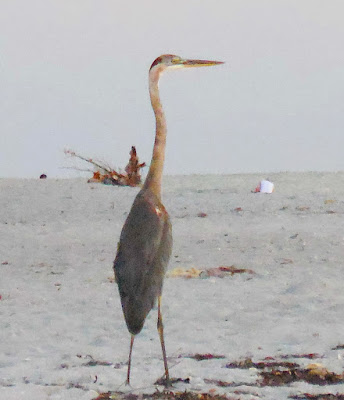Death arrived before the healing could
 |
| A Great Blue Heron at Blind Pass Beach |
February 22, 2016, I sat in the sun, my eyes closed, for several minutes, blissfully unaware of the gruesome sight just a few feet away from me. I contemplated the past weekend, a whirlwind of dinners with friends, four nights in a row! Many domestic chores were completed, too, including the partial installation of propane service so that soon, we'll be cooking with gas in our kitchen. I moderated the first in a series of new programs called "This is My Story" at church. Tom played at his first outdoor jazz concert this season. The weather has been stunningly beautiful. So on this Monday afternoon, I decided to take advantage of it by moving the lawn chair into the sun on a patch of shell path in our backyard, near the dock.
For some reason, I opened my eyes, and turned my head far around to my right. There lay a dead cormorant on a flagstone next to the house.
"Tom, there's a dead cormorant out here," I called. Tom was plugging in a new light over a table in the breezeway. "What???" he said, sounding incredulous.
"A dead cormorant. Here. By the house. Near the dock." I sputtered.
"I guess we get a shovel and use it to put it in a bag," he said. He always knows what to do.
But Tom's immune system is impaired this Winter, so I wasn't about to allow him to take on this task. Besides, in our house, I'm generally the one who takes out the garbage. I'm picky about sorting the recyclables from the trash.
Ah yes. I had just seen a shovel in the corner of the garage, and I knew right were the heavy duty garbage bags were stashed. I deftly opened a bag, placed it carefully on the ground near the cormorant, and then lifted the bird with the shovel. Lowering the shovel to the bag, I marvelled at how perfectly the limp, fly-riddled creature plopped into the middle of the black plastic, as if it were ready to rest in peace.
Fortunately, the trash collection is today and the truck has not yet arrived. The bird is in the garbage can now, awaiting its ride to the trash burning power plant in the middle of the county. The cormorant's ashes will rest eventually in a landfill, miles away from its native coastal waters.
As soon as I'd placed the bagged cormorant in the garbage can, I wondered if scientists at SCCF or CROW might be looking into dead birds because our area has been experiencing red tide lately. So I called them. They were not investigating. The young man in the hospital at CROW said, "No, we pretty much know what's happening with the birds."
Red tide is a naturally occurring algae in the Gulf of Mexico. But when it is "fed" by nutrients in polluted water, like that of the Lake Okeechobee discharges, the red tide blooms prolifically and its toxins poison fish. Cormorants and other birds eat the poisoned fish, and they can die.
I remember now that in the hours before this morning's dawn, at about 5AM, I heard a couple of odd, airy croaking noises outside. That disturbance may have been the cormorant's death.
While our bayou may not have noticeably received the dark water from Lake Okeechobee or the red tide organisms from the Gulf, it does still host the birds that visit those other, afflicted areas which are so close by. Perhaps the sickened cormorant sought the safer bayou as a refuge, a place to heal. But death arrived before healing could.

The discharge of Lake O is killing many of our native creatures, not only along the Gulf, but the Caloosahatchi River and into our Everglades.
ReplyDelete